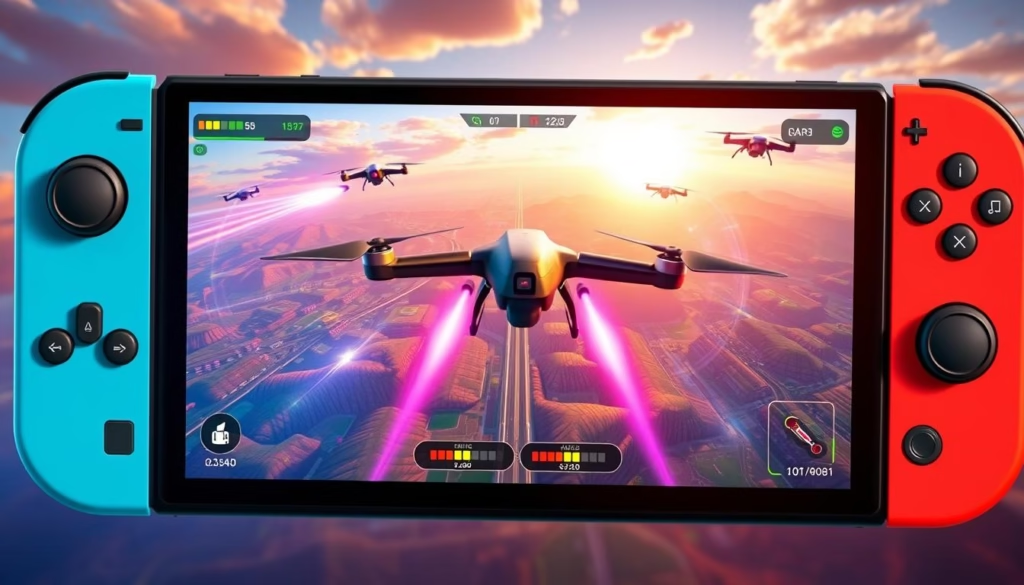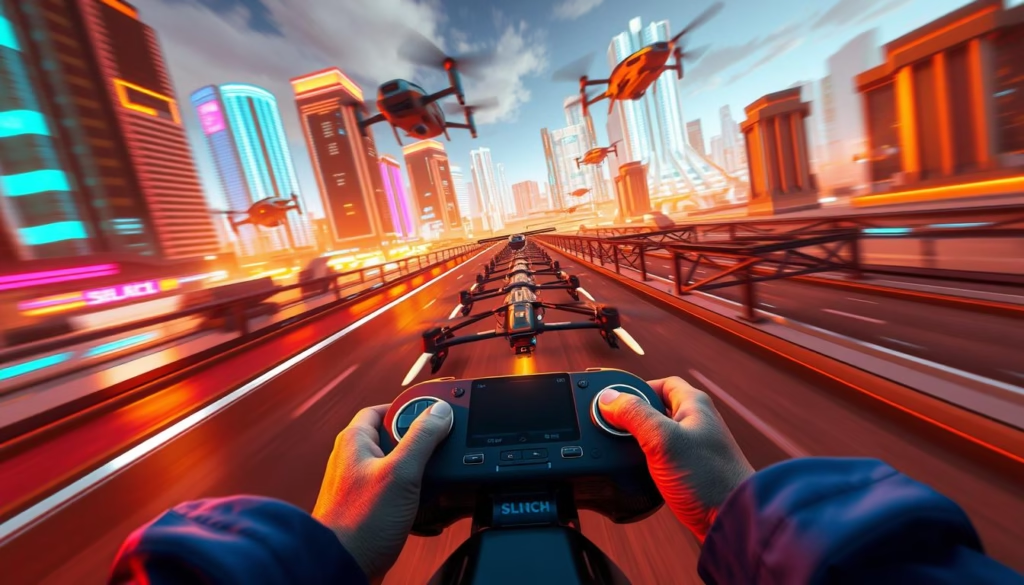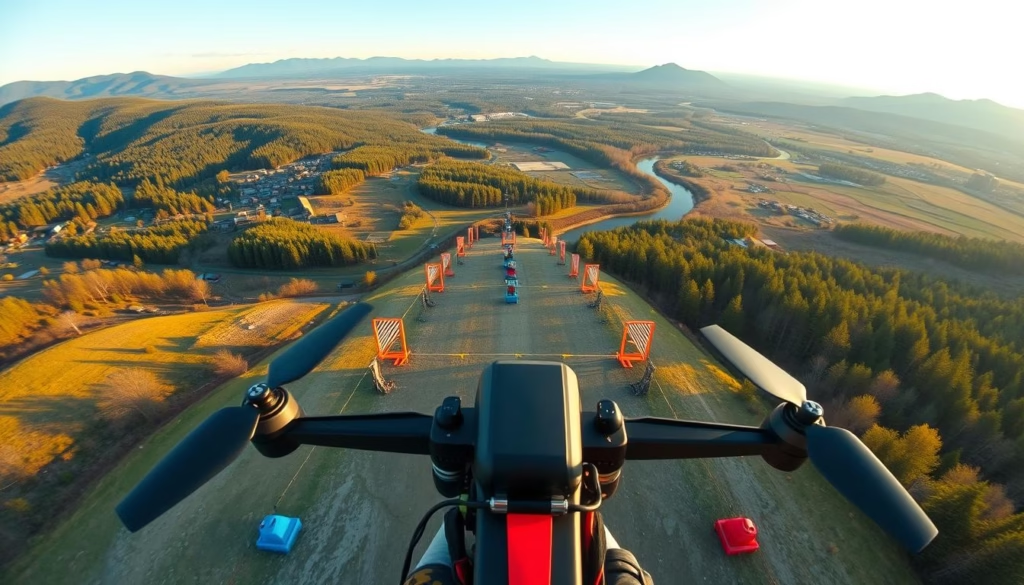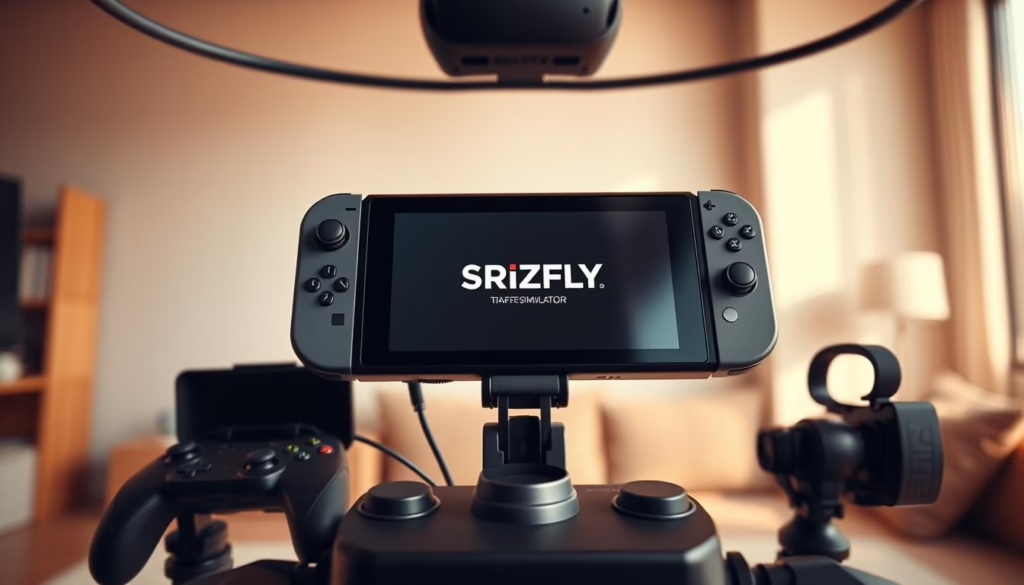Drone enthusiasts and professionals alike are turning to FPV simulators on the Nintendo Switch to hone their skills. This innovative training solution offers a risk-free environment to practice drone flying, eliminating the risk of crashes and costly repairs.
By utilizing a simulator, pilots can develop their skills in a controlled setting, perfecting their techniques without the financial burden of real-world training. The portability of the Nintendo Switch makes it an ideal platform for training on-the-go, outshining PC-based simulators.
Whether you’re a beginner looking to enter the world of drone flying or an experienced pilot seeking to improve your skills, FPV simulators on Nintendo Switch provide a comprehensive training journey. From basic controls to advanced maneuvers, these simulators ensure that you’re well-prepared for real-world flying.
Key Takeaways
- FPV simulators on Nintendo Switch offer a safe and cost-effective training solution.
- They provide a risk-free environment to develop essential drone piloting skills.
- Portability allows for training on-the-go, surpassing PC-based simulators.
- Ideal for both beginners and experienced pilots looking to improve their skills.
- Comprehensive training journey from basic to advanced maneuvers.
Understanding FPV Drone Simulators
Simulators are the backbone of FPV drone training, offering a risk-free environment where pilots can hone their skills. The world of FPV drone racing is complex, requiring a deep understanding of both the technology and the piloting skills.
What Is First Person View (FPV) Flying?
First Person View (FPV) flying refers to the experience of piloting a drone from the perspective of the aircraft itself, typically through video goggles or a screen displaying real-time camera feed. This immersive experience allows for precise control during racing and freestyle maneuvers, making it a favorite among drone enthusiasts.
Why Simulators Are Essential for Drone Pilots
Simulators bridge the gap between theory and practice by providing a realistic flying experience without real-world consequences. They allow pilots to practice in various conditions and scenarios, developing muscle memory and reflexes essential for responsive drone control. The financial benefits are also significant, as crashes in virtual environments don’t result in costly repairs or replacements.
| Benefits of FPV Simulators | Description |
|---|---|
| Risk-Free Practice | Practice flying without the risk of damaging your drone. |
| Improved Skills | Enhance your piloting skills through realistic simulations. |
| Cost-Effective | Reduce costs associated with drone repairs and replacements. |
Benefits of Training with Nintendo Switch FPV Simulators
Nintendo Switch FPV simulators offer a realistic and immersive training experience for drone pilots. By utilizing these simulators, pilots can significantly improve their flying skills in a safe and controlled environment.
Cost-Effective Practice Without Crash Risks
Training with FPV simulators on the Nintendo Switch is cost-effective as it eliminates the risk of crashing and damaging expensive drone equipment. Beginners can practice aggressive maneuvers and racing techniques without the anxiety of causing damage, saving on potential repair costs.
Portable Training Anywhere, Anytime
The Nintendo Switch’s portability allows pilots to train during commutes, travel, or whenever they have spare moments. This portability creates more consistent practice opportunities compared to PC-based simulators that require dedicated setups.
Skill Development in a Controlled Environment
FPV simulators provide a controlled environment where pilots can isolate specific skills for focused practice. Weather-independent training ensures consistent skill development, and simulators can create progressive learning scenarios that gradually increase in difficulty as skills improve.
How Nintendo Switch FPV Simulator Enhances Your Drone Skills
By utilizing the Nintendo Switch FPV simulator, pilots can refine their techniques in a controlled environment. This simulator is designed to help you improve your drone flying skills through a variety of training modes and exercises.
Mastering Basic Controls and Maneuvers
New pilots must master fundamental control skills, including throttle management, yaw control, and coordinated turns. The simulator provides immediate feedback on control inputs, accelerating the learning process for basic maneuvers.
Progressing from Beginner to Advanced Techniques
The simulator offers a progressive skill development path, from hovering and basic navigation to advanced racing lines and freestyle tricks. As you become more comfortable with the controls, you can advance to more complex techniques.
Developing Muscle Memory for Real-World Flying
Repetitive practice in the simulator builds the neural pathways necessary for intuitive drone control. This develops muscle memory, translating to smoother, more precise control when flying real drones.
| Skill Level | Simulator Mode | Techniques Learned |
|---|---|---|
| Beginner | Beginner Mode | Basic Controls, Hovering |
| Intermediate | Intermediate Mode | Navigation, Simple Tricks |
| Advanced | Pro Mode | Advanced Racing Lines, Freestyle Tricks |
FPV Simulator by Benjamin Kistler

The FPV Simulator, developed by Benjamin Kistler, brings the thrill of drone racing to the Nintendo Switch. This simulator is designed for both beginners and advanced pilots, offering a comprehensive training experience.
Overview
FPV Simulator is a dedicated drone simulator that provides a realistic first-person view racing experience on the Nintendo Switch. Released on February 18, 2022, it features a structured approach to skill development.
Key Features
The simulator includes a flight school with 7 tutorials that guide users through progressive skill levels. It also offers 6 time trial race tracks and 6 free flight environments for varied practice.
Flight School with 7 Tutorials
The flight school is designed to help users master basic controls and advanced maneuvers through its comprehensive tutorials.
Race Tracks and Free Flight Environments
The simulator features diverse race tracks for competitive flying and free flight environments for creative practice.
Pros and Cons
The FPV Simulator offers accessibility and a structured learning approach, making it ideal for new pilots. However, it may have graphics limitations compared to PC simulators and potential control sensitivity issues.
Pricing and Availability
The FPV Simulator is available on the Nintendo eShop. Check the current pricing and any bundle options or discounts that may be available.
Game Modes in Nintendo Switch FPV Simulators
Nintendo Switch FPV simulators offer a variety of game modes to enhance your drone flying skills. These modes are designed to cater to different aspects of drone piloting, from competitive racing to freestyle tricks.
Time Trial Mode: Racing Against the Clock
Time Trial mode challenges you to beat your personal best times, creating a progressive system that adapts to your skill level. This mode develops critical skills such as racing line awareness, throttle control, and turning precision, essential for competitive drone racing.
Free Flight Mode: Perfecting Freestyle Tricks
Free Flight mode provides a creative space to practice freestyle maneuvers without time constraints. It helps build spatial awareness and control finesse, translating to more artistic real-world flying.
Tutorial Modes for Skill Building
Tutorial modes break down complex skills into manageable segments, creating a solid foundation before advancing to challenging scenarios. Switching between these modes ensures a well-rounded training regimen, developing complementary skill sets.
| Game Mode | Primary Skill Developed | Benefit |
|---|---|---|
| Time Trial | Racing Line Awareness | Improved Competitive Racing Skills |
| Free Flight | Spatial Awareness | Enhanced Artistic Flying Capabilities |
| Tutorial | Fundamental Skills | Solid Foundation for Advanced Techniques |

Customization Options for Your Virtual Drone
With the Nintendo Switch FPV simulator, you can personalize your drone to suit your flying style. This customization enhances your overall flying experience and improves your skills.
Adjusting Stick Sensitivity and Controls
Adjusting stick sensitivity is crucial for a realistic and responsive control experience. The simulator offers four predefined stick sensitivity options for each control axis, allowing you to tailor the controls to your preference. This feature is essential for matching the simulator’s behavior to your real-world drone.
Predefined Drone Settings for Different Skill Levels
The simulator includes three predefined drone settings designed for different skill levels: beginner, intermediate, and advanced. These settings modify flight characteristics to match your skill level, providing a more forgiving experience for beginners and a more responsive experience for advanced pilots.
Creating Your Personalized Flight Experience
By combining stick sensitivity adjustments with predefined drone settings, you can create a personalized flight experience. Experimenting with different settings helps you understand how various parameters affect flight characteristics, improving your skills and transferring them to real-world flying.
| Setting | Description | Skill Level |
|---|---|---|
| Stick Sensitivity | Four predefined options for each axis | All |
| Drone Settings | Predefined settings for different skill levels | Beginner, Intermediate, Advanced |
| Flight Experience | Personalized based on stick sensitivity and drone settings | All |
Progression Path: From Beginner to Pro Pilot
The journey to becoming an expert FPV pilot involves gradual progression through different modes. To achieve mastery, pilots must start with the basics and gradually advance to more complex skills.
Starting with Beginner Mode
Beginner Mode is designed for new pilots, offering stabilization assists, reduced speeds, and simplified control responses to build fundamental skills. This mode provides a structured learning path, allowing pilots to achieve specific milestones before advancing to more challenging settings.
- Simplified controls for easy learning
- Reduced speeds to minimize crash risks
- Stabilization assists for smooth flying
Advancing to Intermediate Settings
As pilots become more comfortable, they can transition to Intermediate Settings, where some assists are removed and speeds increase. This mode helps develop more precise control techniques, including coordinated turns, basic racing lines, and introductory freestyle maneuvers.
- Increased speeds for more challenging flying
- Removal of some assists to improve skill development
- Introduction to advanced techniques like freestyle
Mastering Pro Mode Capabilities
Pro Mode unlocks the full potential of FPV flying, offering maximum speeds, responsive control settings, and a realistic physics simulation. Mastering this mode prepares pilots for competitive racing and advanced freestyle flying in real-world scenarios.
By progressing through these modes, pilots can develop their skills in a structured and efficient manner. The key is to practice consistently and alternate between modes to identify areas for improvement.
Realistic Flight Physics in Nintendo Switch FPV Simulators
Nintendo Switch FPV simulators have revolutionized drone training with their realistic flight physics. These simulators provide an immersive experience that closely mimics real-world FPV flying, allowing pilots to hone their skills in a safe and controlled environment.
How Accurate Are the Simulations?
The simulations on Nintendo Switch FPV simulators are remarkably accurate, capturing the nuances of flight physics such as momentum, prop wash, and air resistance. This accuracy helps pilots develop a realistic understanding of drone behavior.
Transferring Virtual Skills to Real-World Flying
Skills learned in the simulator transfer effectively to real-world FPV flying. Pilots can expect to perform better and adapt quicker to actual drone handling due to the muscle memory developed during simulation.
Physics Limitations on the Nintendo Switch Platform
While the Nintendo Switch offers impressive simulation capabilities, its hardware has limitations compared to high-end PC simulators. These limitations can affect the complexity of physics calculations, potentially leading to minor discrepancies in flight behavior.
| Feature | Nintendo Switch FPV Simulators | High-End PC FPV Simulators |
|---|---|---|
| Physics Accuracy | High | Very High |
| Processing Power | Limited | High |
| Portability | Yes | No |
Training Exercises to Improve Your FPV Skills
To become a proficient FPV pilot, it’s essential to engage in targeted training exercises that enhance your FPV skills. The simulator provides an ideal environment for this purpose.
Gate Racing Practice Techniques
Gate racing practice involves navigating through gates with precision. Techniques include slalom patterns, figure-eight drills, and split-S approaches. As you improve, decrease gate sizes and increase speeds to challenge your racing skills.
Freestyle Maneuver Drills
Freestyle maneuvers require practice and patience. Start with basic flips and rolls, then progress to complex combinations like power loops and split-S turns. Break down complex tricks into component parts for focused practice.
Creating Effective Practice Routines
Create structured practice routines with warm-up exercises, focused skill development, and challenge scenarios. Use the simulator’s replay features to analyze mistakes and refine techniques. Deliberate practice with specific goals is key to improving your FPV skills.

Comparing Nintendo Switch FPV Simulators to Other Platforms
Nintendo Switch FPV simulators have emerged as a popular choice among drone pilots. When evaluating FPV simulators, it’s essential to compare the Nintendo Switch with other platforms like PC and mobile devices.
Switch vs. PC FPV Simulators
PC FPV simulators like Velocidrone, Liftoff, and DRL Simulator offer advanced graphics and physics. However, they require powerful hardware, increasing the overall cost. In contrast, Nintendo Switch FPV simulators provide a more affordable and portable solution without significant compromises in simulation quality.
Switch vs. Mobile FPV Apps
Mobile FPV apps are convenient but often lack the precision of physical controllers. The Nintendo Switch offers a better control experience with its Joy-Con or Pro Controller, making it more suitable for serious training.
Portability vs. Performance Considerations
While PC setups offer higher performance, the Nintendo Switch excels in portability. This makes it ideal for pilots who need to train in different locations. A comparison of key features is summarized below:
| Feature | Nintendo Switch | PC | Mobile |
|---|---|---|---|
| Portability | High | Low | High |
| Graphics Quality | Medium | High | Low-Medium |
| Control Precision | High | High | Low-Medium |
Ultimately, the choice depends on your budget, training goals, and lifestyle. Using multiple platforms can also provide complementary training benefits.
Controller Options and Setup Tips
When it comes to FPV simulation on the Nintendo Switch, choosing the right controller is crucial for an immersive experience. The Switch offers versatile controller options that cater to different preferences and needs.
Using Nintendo Switch Joy-Cons for FPV
The standard Joy-Con controllers can be used for FPV simulation, offering a compact and convenient option. While they have smaller analog sticks and buttons, their controls can be mapped effectively for drone simulation. Adjusting the stick sensitivity can help maximize their effectiveness for FPV.
Pro Controller Benefits for Simulation
The Nintendo Switch Pro Controller provides improved stick precision and ergonomics, making it ideal for longer simulation sessions. Its design closely mimics actual drone transmitters, offering a more realistic simulation experience. This can be particularly beneficial for serious FPV enthusiasts.
Optimal Controller Settings for Realistic Feel
To achieve a realistic feel, adjusting the settings is key. This includes tweaking dead zones, sensitivity curves, and mode selection (Mode 1, 2, 3, or 4) to match your real-world transmitter. Proper settings can significantly enhance the FPV experience, making the simulator more effective for training.
Who Should Use Nintendo Switch FPV Simulators
Whether you’re just starting out or looking to refine your skills, Nintendo Switch FPV simulators offer a comprehensive training solution. The FPV simulator is designed to cater to drone pilots of all levels, providing a safe and cost-effective way to improve your flying skills.
Perfect for Drone Beginners
For beginners, Nintendo Switch FPV simulators serve as an excellent introduction to the world of drone flying. The structured tutorials and progressive difficulty settings create an ideal learning environment, allowing new pilots to develop fundamental skills without the risk of damaging expensive hardware. By practicing with the simulator, beginners can build confidence and prepare themselves for real-world flying.
Benefits for Intermediate Pilots
Intermediate pilots can refine their techniques, practice challenging maneuvers, and develop consistency in their flying using the Nintendo Switch FPV simulator. The simulator provides a platform to experiment with more aggressive flying styles, such as freestyle flying, before attempting them with real equipment. This helps in reducing the risk of damage to the drone and improves overall flying skills.
Value for Advanced Flyers
Even advanced pilots and professionals can benefit from using Nintendo Switch FPV simulators. They can maintain their skills during off-seasons, test new racing lines, and develop cutting-edge freestyle combinations. The portability of the Switch also allows pilots to maintain their skills while traveling, making it an invaluable tool for those with busy schedules.
| Pilot Level | Benefits |
|---|---|
| Beginners | Low-risk entry, skill development, cost-effective |
| Intermediate Pilots | Refine techniques, practice challenging maneuvers, experiment with aggressive styles |
| Advanced Pilots | Maintain skills, test new racing lines, develop freestyle combinations |
Conclusion: Taking Your Drone Skills to New Heights
Nintendo Switch FPV simulators offer a comprehensive training solution that addresses the needs of both beginner and experienced drone pilots. These simulators provide a cost-effective way to develop and refine flying skills without the risk of damaging real drones. The portability of the Nintendo Switch means you can practice anytime, anywhere, making consistent training a reality regardless of weather or location.
The structured progression path from beginner to advanced pilot is a key benefit, with simulator modes designed to challenge and improve your abilities. Skills developed in the simulator translate well to real-world flying, with minimal adjustment needed. To get the most out of your training, combine different simulator modes for a well-rounded skill development. Whether you’re into FPV racing or freestyle flying, these simulators are an invaluable tool.
As drone technology continues to evolve, the importance of simulator training will only grow. We recommend embracing simulator training as an ongoing complement to your real-world flying, not just a beginner’s tool. With Nintendo Switch FPV simulators, you’re taking your drone skills to new heights.
FAQ
What is the primary purpose of using a drone simulator?
The primary purpose of using a drone simulator is to train safely and efficiently, allowing pilots to develop their skills without the risk of damaging a real drone.
How do drone simulators help in improving drone flying skills?
Drone simulators provide a controlled environment where pilots can practice and master various flying techniques, including freestyle tricks and racing, under different settings and conditions.
Can drone simulators be used by pilots of all skill levels?
Yes, drone simulators are designed to cater to pilots of all skill levels, from beginners to advanced flyers, offering adjustable settings and modes to suit individual needs.
What are the benefits of using a drone simulator over real-world flying?
Using a drone simulator offers several benefits, including cost-effectiveness, reduced risk of damage, and the ability to practice anywhere, anytime, without weather or location constraints.
How realistic are the flight physics in drone simulators?
Modern drone simulators, such as those available on the Nintendo Switch, offer realistic flight physics, allowing pilots to develop skills that can be effectively transferred to real-world flying.
Can I customize the controls and settings in a drone simulator?
Yes, most drone simulators offer customization options, including adjustable stick sensitivity and predefined drone settings, to create a personalized flight experience.
Are drone simulators suitable for training for specific drone applications?
Yes, drone simulators can be used to train for various drone applications, including racing, freestyle flying, and other specialized uses, helping pilots to develop the necessary skills and techniques.
How do I choose the right drone simulator for my needs?
When choosing a drone simulator, consider factors such as the level of realism, available game modes, customization options, and compatibility with your device or controller, to ensure it meets your training requirements.



